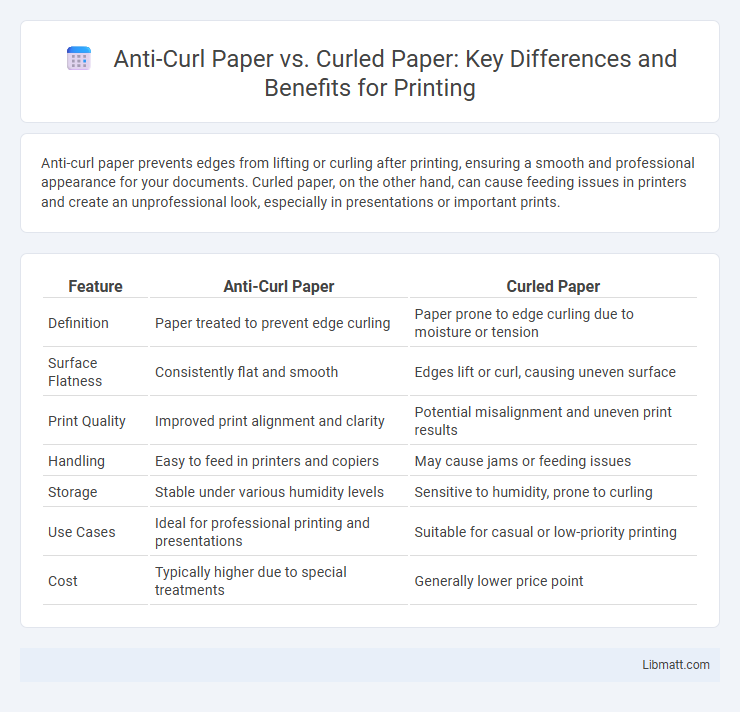Anti-curl paper prevents edges from lifting or curling after printing, ensuring a smooth and professional appearance for your documents. Curled paper, on the other hand, can cause feeding issues in printers and create an unprofessional look, especially in presentations or important prints.
Table of Comparison
| Feature | Anti-Curl Paper | Curled Paper |
|---|---|---|
| Definition | Paper treated to prevent edge curling | Paper prone to edge curling due to moisture or tension |
| Surface Flatness | Consistently flat and smooth | Edges lift or curl, causing uneven surface |
| Print Quality | Improved print alignment and clarity | Potential misalignment and uneven print results |
| Handling | Easy to feed in printers and copiers | May cause jams or feeding issues |
| Storage | Stable under various humidity levels | Sensitive to humidity, prone to curling |
| Use Cases | Ideal for professional printing and presentations | Suitable for casual or low-priority printing |
| Cost | Typically higher due to special treatments | Generally lower price point |
Introduction to Paper Curling Issues
Paper curling occurs due to uneven moisture absorption and drying, causing sheets to deform and impact print quality and handling. Anti-curl paper is engineered with balanced moisture content and fiber orientation to resist curling, ensuring flatness during printing and finishing processes. Using anti-curl paper minimizes jams and misfeeds in printers, improving efficiency compared to standard curled paper prone to warping.
What is Anti-Curl Paper?
Anti-curl paper is specially engineered to resist the natural tendency of printed sheets to curl, ensuring flatness for smooth feeding and accurate printing. It incorporates balanced moisture content and fiber distribution to counteract the stresses caused by ink absorption and drying processes. This stability enhances print quality and reduces paper jams compared to curled paper, which often warps due to uneven tension and environmental factors.
Causes and Effects of Paper Curl
Paper curl occurs due to uneven moisture distribution and tension during manufacturing or printing, causing edges to lift or warp. Anti-curl paper is engineered with balanced moisture content and reinforced fibers to prevent deformation, ensuring flatness and ease of handling. Curled paper complicates printing accuracy, causes jams, and negatively impacts final product appearance, whereas anti-curl paper enhances print quality and operational efficiency.
Key Differences: Anti-Curl vs. Curled Paper
Anti-curl paper is specially engineered with balanced moisture content and coating layers to prevent warping and maintain flatness, ensuring superior print quality and smooth feed in printers. In contrast, curled paper results from uneven moisture absorption or improper storage, causing edges to lift or bend, which can lead to paper jams and distorted prints. The key differences lie in their physical stability and performance reliability, where anti-curl paper promotes consistent handling and high-resolution output while curled paper compromises printing efficiency and finished document appearance.
Benefits of Using Anti-Curl Paper
Anti-curl paper significantly enhances print quality by preventing the edges of the paper from curling, which ensures consistent feed through printers and reduces jams. This type of paper maintains a flat surface, improving the accuracy of text and image reproduction, especially in high-resolution printing applications. Using anti-curl paper extends the lifespan of printers and copiers by minimizing mechanical stress caused by curled sheets.
Drawbacks of Curled Paper in Printing
Curled paper often causes misfeeds and jams in printers, leading to increased downtime and wasted supplies. The uneven surface of curled paper results in inconsistent ink absorption, producing poor print quality and smudged images. You may experience difficulty in stacking and handling this paper, which disrupts workflow efficiency and raises operational costs.
Common Applications for Anti-Curl Paper
Anti-curl paper is commonly used in professional printing environments, including graphic design, photography, and high-quality document applications where a flat, smooth finish is essential. This paper type prevents deformation during printing or handling, ensuring your prints maintain a professional appearance without edges lifting or curling. It is preferred for presentations, brochures, and art portfolios, where durability and pristine aesthetics are crucial.
How to Prevent Paper Curl
To prevent paper curl effectively, use anti-curl paper designed with balanced moisture content and fiber alignment to maintain flatness during printing and handling. Proper storage in a controlled environment with optimal humidity levels between 40-60% reduces the risk of curled paper by preventing moisture absorption or loss. Ensure your printer settings match the paper type, and consider using a humidifier or flat weight stacking to keep your prints smooth and professional-looking.
Choosing the Right Paper for Your Needs
Anti-curl paper is engineered with balanced fiber orientation and moisture control to prevent curling, making it ideal for high-quality printing and professional presentations that require flat, smooth surfaces. In contrast, curled paper often results from uneven moisture absorption or fiber tension during manufacturing, leading to handling difficulties and potential print defects. Selecting anti-curl paper ensures durability and consistent print quality, while curled paper may be suitable for less critical applications where budget considerations outweigh the need for perfect presentation.
Final Thoughts: Anti-Curl Paper vs. Curled Paper
Anti-curl paper ensures a flat, professional finish ideal for high-quality prints and precise handling, reducing issues like paper jams and misfeeds. Curled paper often occurs due to moisture imbalance or printing heat, leading to uneven output and compromised print quality. Choosing anti-curl paper protects your prints from distortion, enhancing the durability and presentation of your documents.
Anti-curl paper vs curled paper Infographic

 libmatt.com
libmatt.com